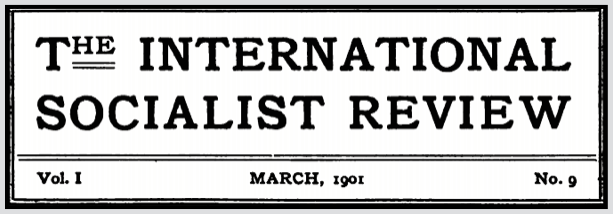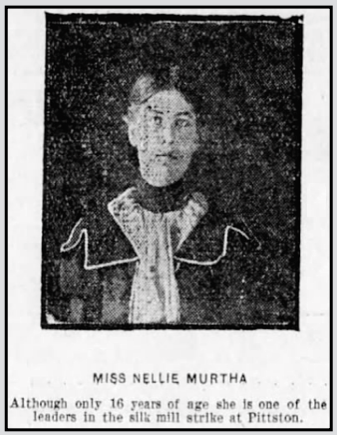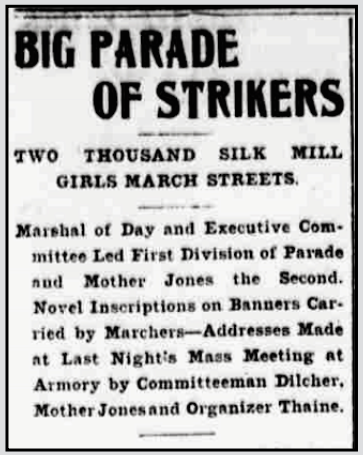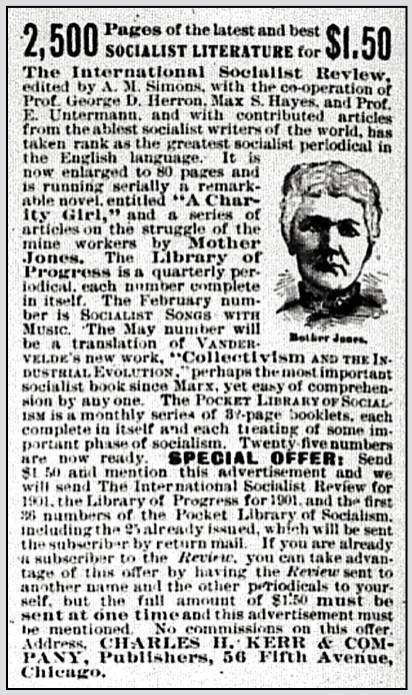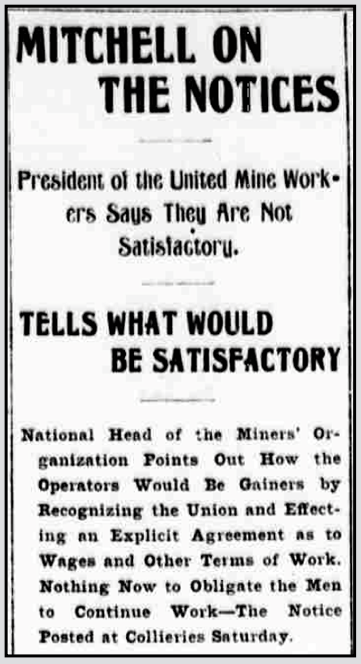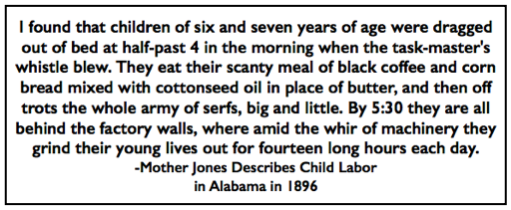 ———-
———-
Hellraisers Journal – Wednesday April 10, 1901
Mother Jones News Round-Up for March 1901, Part I
Found Writing for The Review and Marching with Striking Silk Workers
From the International Socialist Review of March 1901:
Civilization in Southern Mills
———-
The miners and railroad boys of Birmingham, Ala., entertained me one evening some months ago with a graphic description of the conditions among the slaves of the Southern cotton mills. While I imagined that these must be something of a modern Siberia, I concluded that the boys were overdrawing the picture and made up my mind to see for myself the conditions described. Accordingly I got a job and mingled with the workers in the mill and in their homes. I found that children of six and seven years of age were dragged out of bed at half-past 4 in the morning when the task-master’s whistle blew. They eat their scanty meal of black coffee and corn bread mixed with cottonseed oil in place of butter, and then off trots the whole army of serfs, big and little. By 5:30 they are all behind the factory walls, where amid the whir of machinery they grind their young lives out for fourteen long hours each day. As one looks on this brood of helpless human souls one could almost hear their voices cry out, “Be still a moment, O you iron wheels or capitalistic greed, and let us hear each other’s voices, and let us feel for a moment that this is not all of life.”
We stopped at 12 for a scanty lunch and a half-hour’s rest. At 12:30 we were at it again with never a stop until 7. Then a dreary march home, where we swallowed our scanty supper, talked for a few minutes of our misery and then dropped down upon a pallet of straw, to lie until the whistle should once more awaken us, summoning babes and all alike to another round of toil and misery.
I have seen mothers take their babes and slap cold water in their face to wake the poor little things. I have watched them all day long tending the dangerous machinery. I have seen their helpless limbs torn off, and then when they were disabled and of no more use to their master, thrown out to die. I must give the company credit for having hired a Sunday school teacher to tell the little things that “Jesus put it into the heart of Mr. – to build that factory so they would have work with which to earn a little money to enable them to put a nickel in the box for the poor little heathen Chinese babies.”
The Rope Factory
I visited the factory in Tuscaloosa, Ala., at 10 o’clock at night. The superintendent, not knowing my mission, gave me the entire freedom of the factory, and I made good use of it. Standing by a siding that contained 155 spindles were two little girls. I asked a man standing near if the children were his, and he replied that they were. “How old are they?” I asked. “This one is 9, the other 10,” he replied. “How many hours do they work?” “Twelve,” was the answer. “How much do they get a night?” “We all three together get 60 cents. They get 10 cents each and I 40.”
I watched them as they left their slave-pen in the morning and saw them gather their rags around their frail forms to hide them from the wintry blast. Half-fed, half-clothed, half-housed, they toil on, while the poodle dogs of their masters are petted and coddled and sleep on pillows of down, and the capitalistic judges jail the agitators that would dare to help these helpless ones to better their condition.
Gibson is another of those little sections of hell with which the South is covered. The weaving of gingham is the principal work. The town is owned by a banker who possesses both people and mills. One of his slaves told me she had received one dollar for her labor for one year. Every weekly pay day her employer gave her a dollar. On Monday she deposited that dollar in the “pluck-me” store to secure food enough to last until the next pay day, and so on week after week.
There was once a law on the statute books of Alabama prohibiting the employment of children under twelve years of age more than eight hours each day. The Gadston Company would not build their mill until they were promised that this law should be repealed.
When the repeal came up for the final reading I find by an examination of the records of the House that there were sixty members present. Of these, fifty-seven voted for the repeal and but three against. To the everlasting credit of young Manning, who was a member of that House, let it be stated that he both spoke and voted against the appeal.
I asked one member of the House why he voted to murder the children, and he replied that he did not think they could earn enough to support themselves if they only worked eight hours. These are the kind of tools the intelligent workingmen put in office.
The Phoenix mill in [Columbus] Georgia were considering the possibility of a cut in wages something over a year ago, but after making one attempt they reconsidered and started a savings bank instead. At the end of six months the board of directors met and found out that the poor wretches who were creating wealth for them were saving 10 per cent of their wages. Whereupon they promptly cut them that 10 per cent, and the result was the ’96 strike. I wonder how long the American people will remain silent under such conditions as these.
Almost every one of my shop-mates in these mills was a victim of some disease or other. All are worked to the limit of existence. The weavers are expected to weave so many yards of cloth each working day. To come short of this estimate jeopardizes their job. The factory operator loses all energy either of body or of mind. The brain is so crushed as to be incapable of thinking, and one who mingles with these people soon discovers that their minds like their bodies are wrecked. Loss of sleep and loss of rest gives rise to abnormal appetites, indigestion, shrinkage of stature, bend backs and aching hearts.
Such a factory system is one of torture and murder as dreadful as an long-drawn-out Turkish massacre, and is a disgrace to any race or age. As the picture rises before me I shudder for the future of a nation that is building up a moneyed aristocracy out of the life-blood of the children of the proletariat. It seems as if our flag is a funeral bandage splotched with blood. The whole picture is one of the most horrible avarice, selfishness and cruelty and is fraught with present horror and promise of future degeneration. The mother, over-worked and under-fed, gives birth to tired and worn-out human beings.
I can see no way out save in a complete overthrow of the capitalistic system, and to me the father who casts a vote for the continuance of that system is as much of a murderer as if he took a pistol and shot his own children. But I see all around me signs of the dawning of the new day of socialism, and with my faithful comrades everywhere I will work and hope and pray for the coming of that better day.
Mother Jones
From the Philadelphia Times of March 1, 1901:
ONLY A BLUFF
———-
“Mother” Jones Says Silk Mills Will
Not Move to Georgia.Special Telegram to THE TIMES.
Pittston, February 28.
“Mother” Jones, when asked to-day if the report that the silk mill owners will remove the looms to Georgia has had any effect on the strike, said:
It is only a bluff. There is no danger of such action. The operators know that they cannot begin to get work done cheaper than they can in this section of the country. The strikers will remain solid, and instead of moving to other sections the operators will come to terms and grant the girls’ demands.
The situation to-day was unchanged save for the absence of the mill owners from this city. That they are in Georgia is certain, but whether the threat of removal will be carried out can only be surmised.
The strikers have gained popular favor in this latest move and their leaders are confident that the silk industry will stay in this city and that the strike will end within two weeks.
———-
[Photograph added.]
From the Philadelphia Times of March 3, 1901:
END IS IN SIGHT
—–
Peaceful Solution of Great Silk Strike
Will be Arrived At.Special Telegram to THE TIMES.
Scranton, March 2.
The end of the silk mill strike is in sight. Superintendent Davis, of the Saquoit mill, has been telegraphed to return from the South for a conference with the general committee of the strikers, “Mother” Jones, Fred Dilcher and President Keenan, of Paterson, N. J., the head of the silk workers’ organization. There is every reason to believe that this conference will result in a settlement of the strike.
Organizer Dlicher said to THE TIMES correspondent: “I think there will be no trouble whatever about this after the representatives of both sides get their heads together and talk things over calmly.”
Answers to the appeal sent out several days ago are coming in more steadily now, and the treasury is in good condition.
———-
From the Scranton Tribune of March 8, 1901:
One of the most unique sights ever viewed on the streets of this city was seen yesterday, when great numbers of spectators watched at least two thousand of the striking silk mill girls parade the central thoroughfares, marching in excellent order and with precise step to the music of several bands and drum corps.
The delegations expected from Wilkes-Barre and Pittston did not arrive, but all of the local mills turned out big representations. After the parade, lunch was served to the younger children at Carpenters’ hall, and last night a mass meeting was held at the armory, at which addresses were made by Mother Mary Jones, Committeeman Frederick Dilcher and others.
Yesterday’s parade may be said to be one of the first in the history of the county in which almost the entire number of participants were young girls, and the remainder small boys. It formed on Wyoming avenue, and stared on the line of march about 2.45 o’clock.
All along its route the streets were crowded by interested spectators, eager to see the girls who have now been out on strike for six weeks. Mother Mary Jones was also an object of much attention and frequent cheers saluted the gray-haired organizer or the mine workers.
[…..]
AN OMINOUS PLACARD.
The few girls who are still at work were threatened by an ominous placard daubed with red paint bearing the announcement, “Only a few more days left for scabs to work.” “Bosses allow us three drinks of water a day; their own drinks are unlimited,” was another shot at the employers.
The first division was closed by a big representation of girls from Valentine Bliss’ Dickson mill. They were preceded by a large number of small breaker boys carrying large American flags, and many of the strikers also carried national banners. “Hurrah for the Textile Workers against tyranny and robbery,” was their sentiment expressed on a sign carried.
The second division followed about twenty yards behind, and was headed by Mother Jones. The latter walked side by side with Miss Mary Manning, ex-president of the Sauquoit soft silk workers, and a member of the executive committee, Miss Lida Healey, secretary of the Sauquoit union, was also in the van of this part of the procession…..
LUNCHEON SERVED.
When Carpenters’ hall was reached and the young children began to march in to obtain the luncheon which had been donated by local merchants, a scene of indescribable confusion ensued. There was a sudden rush for the door, and in an instant there was a confused mass of children struggling for admittance…..
“I carried a banner in dis parade, an’ I want something to eat,” angrily roared one little breaker boy. Mother Jones appeared at one of the windows on the second floor of the Economy furniture store and announced that no more refreshments would be served, but that they would be instead sent to the various locals. This broke up the crowd, which gradually dispersed.
Last night’s mass meeting held at the armory, was attended by between fifteen and sixteen hundred persons, the majority of whom were silk mill girls. Addresses were made by Dilcher. Mother Jones and [A. F. L.] Organizer Thaine, of Wilkes-Barre.
[…..]
Chairman Dilcher [following the speech of Charles J. Thaine] announced, preparatory to introducing Mother Jones, that the silk workers of this city and vicinity are willing at any time to submit the settlement of their grievances to arbitration, after which he introduced his “friend and the friend of humanity, Mother Jones.”
In the course of her speech the latter said that one of the greates questions of the age was before the strikers. She vigorously declared that many of the children toiling in the mills should be at the public schools, and then drew the attention of the city clergy to the existing condition of affairs.
MOTHER JONES’ APPEAL.
[She said:]
We do not wish to blame individuals, but we did come here to appeal to broader manhood and conscience for a change in the local conditions. Every thinking person realizes that today’s army of young girls will be the future mothers of this nation. Should we slaughter their lives and leave a broken-down race of physical wrecks for the coming generation?
She closed her address by a fervent appeal “to the grander manhood of the men of this city in behalf of the striking children.”
Chairman Dilcher then announced that the strikers were willing to submit the question to arbitration, and named Bishop Hoban as a desirable person to arbitrate the condition. Any other local divine, he said, would also be accepted as arbitrator….
———-
From the Social Democratic Herald of March 9, 1901:
———-
From the Scranton Tribune of March 11, 1901:
President John Mitchell, of the United Mine Workers of America, arrived here yesterday afternoon from Indianapolis on the 3.33 Delaware, Lackawanna and Western train, and stopped off for a day before proceeding to the Hazleton convention. He was accompanied by his secretary, Miss Elizabeth Morris, who was with him during the big strike last fall, and who will act as stenographer of tho secret sessions of the convention.
Mr. Mitchell spent the afternoon and last night in conference with the local labor leaders at the St. Charles, District President T. J. Nicholls, Secretary John T. Dempsey, National Organizer Fred Dilcher, Organizer Robert N. Courtright. “Mother” Jones and Martin D. Flaherty, president of the Central Labor union, were among those who conferred with him…..
———-
Note: Emphasis added throughout.
~~~~~~~~~~~~~~~~~~~~~~
SOURCES & IMAGES
Quote Mother Jones re Child Labor AL 1896, ISR p539, Mar 1901
https://www.marxists.org/history/usa/pubs/isr/v01n09-mar-1901-ISR-gog-Wisc.pdf
https://www.newspapers.com/clip/72449161/may-9-1896-appeal-to-reason-mother/
International Socialist Review
(Chicago, Illinois)
-Mar 1901
https://www.marxists.org/history/usa/pubs/isr/v01n09-mar-1901-ISR-gog-Wisc.pdf
The Times
(Philadelphia, Pennsylvania)
-Mar 1, 1901
https://www.newspapers.com/image/52581042/
-Mar 3, 1901
https://www.newspapers.com/image/52581072/
Scranton Tribune
(Scranton, Pennsylvania)
-Mar 8, 1901
https://chroniclingamerica.loc.gov/lccn/sn84026355/1901-03-08/ed-1/seq-10/
-Mar 11, 1901
https://chroniclingamerica.loc.gov/lccn/sn84026355/1901-03-11/ed-1/seq-5/
Social Democratic Herald
(Chicago, Illinois)
-Mar 9, 1901
https://www.marxists.org/history/usa/pubs/social-democratic-herald-us/010309-socdemherald-v03n38w140.pdf
IMAGE
Nellie Murtha, PA Silk Strike, Phl Tx p6, Mar 3, 1901
https://www.newspapers.com/image/52581072/
See also:
Tag: Pennsylvania Silk Mill Workers Strikes of 1901
https://weneverforget.org/tag/pennsylvania-silk-mill-workers-strikes-of-1901/
Note: Unable to find information on “President Keenan, of Paterson, N. J., the head of the silk workers’ organization.” More research needed. Any info greatly appreciated.
Hellraisers Journal – Friday March 1, 1901
Mother Jones Remembers “Civilization in Southern Mills” of 1896
Hellraisers Journal – Friday March 15, 1901
Chicago, Illinois – Sketch of Mother Jones, Ad for Publications of Charles H. Kerr
Mother Jones News Round-Up for February 1901
Part I: Found Speaking in Cleveland, Ohio, at Labor Lyceum Meeting
Part II: Found Speaking to Striking Silk Mill Workers in Scranton, Pennsylvania
Part III: Found Standing with Striking Silk Mill Workers of Pennsylvania
~~~~~~~~~~~~~~~~~~~~~~~~~~~~~~~~~~~~~
Children of Mother Jones by Pete Duffy

